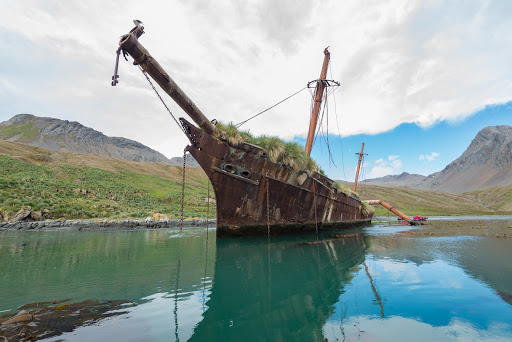The crossing from the Falklands to Ushuaia only took a full day late on the first evening we arrived back in port in heavy winds after a not as gentle as usual crossing. During the crossing we were given information on when we were to leave the ship the following morning – unfortunately I had been given the early flight out so I had to leave early, before most people were up meaning I didn’t get the chance to say goodbye to a fraction of those I wanted to say goodbye to.
Looking back while sailing through the Beagle Channel.
I arrived back in BA and checked into my hotel and rested. I had planned on grabbing (another) steak dinner when here, but realized that the amounts of good food from the past 3 weeks started to make itself known and I felt completely full despite only having a small breakfast on the ship. I was flying out in the late afternoon so the following morning I had a short back in the national park I also visited when I had arrived from home, I hadn’t brought my camera equipment as I just wanted to walk and relax and I hadn’t expected to see anything that would grab my attention. Colour me surprised when leaving the park, I spotted a humming bird buzzing around a tree. Something a long lens would have been perfect for. Oh, well.
Grabbed a cab to the airport, checked in, boarded in a timely manner and once again I received the royal treatment on the flight home. I probably got even more sleep than on the last flight, and gently woken up by a crew member shaking my shoulder informing me it was time for breakfast. Spent my layover in the first class terminal again, and nearing the time of expected departure one of the attendants came over with a grave look on her face. I was expecting to be told that the flight had been cancelled, but instead she was so very sorry to inform me that my flight had been delayed 10 minutes. How horrible! As I was the only one from the terminal getting on that flight the driver drove me to the gate in a Porsche Carrera, very comfortable I must say. Took the elevator up from the tarmac as before, got pushed past the entire queue and put in my seat.
It’s going to be tough getting back to monkey class after this!
And that was a very successful trip over and done with. The sightings were amazing – especially the wildlife! The orca sightings are going to stick with me, and the fact that despite the vulnerable status we saw so many of the various albatrosses! We were told not to get our hopes up, especially with the wandering as it is rare (which was also why it was so frustrating visiting the toilet on the first sighting!), but the numbers we saw were astonishing, even several of the guides were very surprised by the numbers that were logged.
Big thanks to Dr. Alex Cowan (expedition leader), Neil Rabjohn (assistant expedition leader/naturalist), Kevin Morgan (naturalist), Ignacio Canepa (naturalist), Osi Sharaf (naturalist), Scott Macphail (naturalist/historian), Lyn Mair (ornithologist), Rex Nelson (zodiac technician), Gerard Baker (historian/BBC documentary maker), Pablo Cantua (musician), Daniel Urriza (kayak assistant), Sarah Keenan (kayak master), Matt Burnaby (camping master), Paul Glendell (photograoher) and José Aguilar (ship’s doctor). Big thanks to captain Gilles Cader and hotel manager Gabor Ferencz. And finally big thanks to Randale, Jerome, Louie, Albert, Jay, Joel and the rest of the crew that made the trip as memorable as it ended up being, You guys are amazing!
So much awesomeness in one photo.
Back row: Osi Sharaf (naturalist), Lyn Mair (ornithologist), Paul Glendell (photograoher), Pablo Cantua (musician), Sarah Keenan (kayak master), Matt Burnaby (camping master), Neil Rabjohn (assistant expedition leader/naturalist), Kevin Morgan (naturalist), Scott Macphail (naturalist/historian)
Front row: José Aguilar (ship’s doctor), Gerard Baker (historian/BBC Documentary maker), Rex Nelson (zodiac technician), Ignacio Canepa (naturalist), Alex Cowan (expedition leader), Daniel Urriza (kayak assistant)
Thanks to Bec, Naomi, Ceres, Andrea, Chris, Alex, Steve, David, Michaela and everyone else who I should have mentioned but haven’t for being such a great group of people making the trip as terrific as it was. I hope I get to see you all again some time.
Full album can be found here.






















































